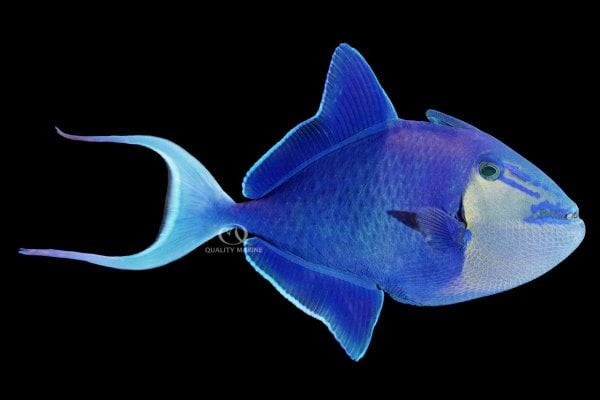The Red-Toothed Triggerfish (Odonus niger) is named after the prominently visible red teeth that it has as an adult. The scientific genus Odonus is of Greek origin and is also a reference to their teeth. Without close inspection the Red-Toothed Trigger might seem unassuming from a distance – but that is far from the truth. When dismissed as simply black, these fish are done an injustice. The truth is that they are a beautiful ombre of purple and dark blues to green teals that form a stunning image when you get to appreciate a mature fish up close in an aquarium setting. The red teeth only add to this, a total departure from the color scheme and a bold highlight – almost as if these fish put on bright red lipstick for a night out! The dorsal, anal and caudal fins are all a light electric blue. In classic pelagic trigger form the mouth is small, with fine teeth designed for eating planktonic prey items they find in the open water. The beautiful lunate (think crescent moon) caudal (or “tail” fin”) has long, trailing edges that accentuate as the fish grows older. These stunning fish can reach a length of almost 16” in the wild and will require a large aquarium. Triggerfish swim using their dorsal (top) fin, and with an anal fin that mirrors the second dorsal fin. The first dorsal fin also has a spiny portion that allows these fish to “trigger” into place in rocks or crevasses keeping them safe from predators when threatened, generating the common name of their family, the triggerfishes or balistidae scientifically.
As planktivores most of their food should be presented in the water column and fall into the category of small meaty prey items. Foods like Gamma enriched brine or mysis and krill are best for recreating what they would normally eat in the wild. They are not picky eaters and will quickly take to most foods provided to them. That said, variety is the spice of life and good for their health. Larger meaty items will also be relished – but it may just take them longer to eat all of it due to their mouth size. Click here to learn more

As planktivores most of their food should be presented in the water column and fall into the category of small meaty prey items. Foods like Gamma enriched brine or mysis and krill are best for recreating what they would normally eat in the wild. They are not picky eaters and will quickly take to most foods provided to them. That said, variety is the spice of life and good for their health. Larger meaty items will also be relished – but it may just take them longer to eat all of it due to their mouth size. Click here to learn more












